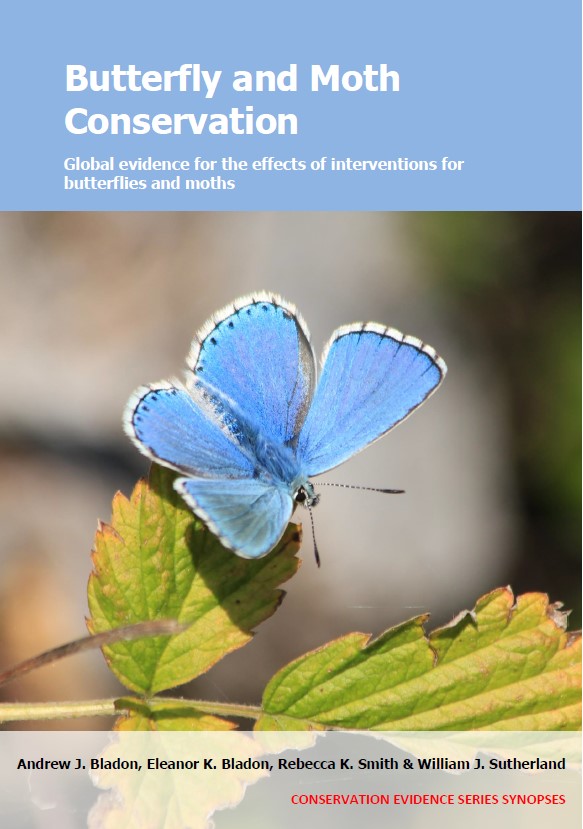Actions to conserve biodiversity
We have summarised evidence from the scientific literature about the effects of actions to conserve wildlife and ecosystems.
Review the evidence from the studies
Not sure what Actions are? Read a brief description.
Search for evidence
e.g. "frogs chytrid"
152 Actions found
Refine
Hide
152 Actions found
Download Actions
| 0 selected |
|
Order results by:
| Action | Effectiveness | Studies | Category | |
|---|---|---|---|---|
|
Use signs and access restrictions to reduce disturbance Action Link |
No evidence found (no assessment) | 0 |
|
|
|
Use shielded “full cut-off” lights to remove outwards lighting Action Link |
Awaiting assessment | 1 |
|
|
|
Use shelterwood harvesting instead of clearcutting Action Link |
Awaiting assessment | 3 |
|
|
|
Use selective or reduced impact logging instead of conventional logging Action Link |
Awaiting assessment | 4 |
|
|
|
Use rotational mowing Action Link |
Awaiting assessment | 10 |
|
|
|
Use rotational grazing Action Link |
Evidence not assessed | 6 |
|
|
|
Use rotational burning Action Link |
Evidence not assessed | 17 |
|
|
|
Use prescribed fire to maintain or restore disturbance in grasslands or other open habitats Action Link |
Evidence not assessed | 13 |
|
|
|
Use prescribed fire to maintain or restore disturbance in forests Action Link |
Evidence not assessed | 5 |
|
|
|
Use patch retention harvesting instead of clearcutting Action Link |
No evidence found (no assessment) | 0 |
|
|
|
Use motor bar mowers rather than rotary mowers Action Link |
Awaiting assessment | 2 |
|
|
|
Use mixed stocking Action Link |
Awaiting assessment | 3 |
|
|
|
Use low intensity lighting Action Link |
Awaiting assessment | 1 |
|
|
|
Use leave-tree harvesting instead of clearcutting Action Link |
No evidence found (no assessment) | 0 |
|
|
|
Use infrastructure to reduce vehicle collision risk along roads Action Link |
Awaiting assessment | 1 |
|
|
|
Use glazing treatments to reduce light spill from inside lit buildings Action Link |
No evidence found (no assessment) | 0 |
|
|
|
Use genetically modified crops which produce pesticide to replace conventional pesticide application Action Link |
Awaiting assessment | 1 |
|
|
|
Use fire suppression/control Action Link |
No evidence found (no assessment) | 0 |
|
|
|
Use fencing to reduce pesticide and nutrient run-off into margins, waterways and ponds Action Link |
No evidence found (no assessment) | 0 |
|
|
|
Use education programmes and local engagement to reduce persecution or exploitation of species Action Link |
No evidence found (no assessment) | 0 |
|
|
|
Use ‘warmer’ (red/yellow) lighting rather than other lighting colours Action Link |
Evidence not assessed | 5 |
|
|
|
Undersow spring cereals, with clover for example Action Link |
Awaiting assessment | 2 |
|
|
|
Translocate to re-establish populations in known or believed former range Action Link |
Evidence not assessed | 16 |
|
|
|
Translocate to establish populations outside of known range Action Link |
Evidence not assessed | 4 |
|
|
|
Thin trees within forests Action Link |
Evidence not assessed | 6 |
|
Download Actions
| 0 selected |
|

Butterfly and Moth Conservation - Published 2023
Butterfly and Moth Synopsis
Watch this search
If you are familiar with RSS feeds, please click the button below to retrieve the feed URL:
RSS feed for this searchIf you are unfamiliar with RSS feeds, we would suggest reading this BBC article.
Unfortunately, due to the number of feeds we have available, we cannot provide e-mail updates. However, you could use tools such as Feed My Inbox to do this for you.
What are 'Individual studies' and 'Actions'?
Individual studies
An individual study is a summary of a specific scientific study, usually taken from a scientific journal, but also from other resources such as reports. It tells you the background context, the action(s) taken and their consequences.
If you want more detail please look at the original reference.
Actions
Each action page focuses on a particular action you could take to benefit wildlife or ecosystems.
It contains brief (150-200 word) descriptions of relevant studies (context, action(s) taken and their consequences) and one or more key messages.
Key messages show the extent and main conclusions of the available evidence. Using links within key messages, you can look at the paragraphs describing each study to get more detail. Each paragraph allows you to assess the quality of the evidence and how relevant it is to your situation.
Where we found no evidence, we have been unable to assess whether or not an intervention is effective or has any harmful impacts.





)_2023.JPG)














